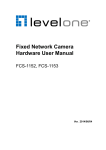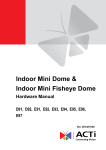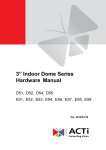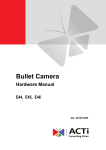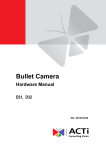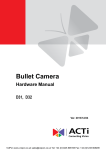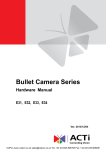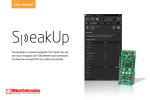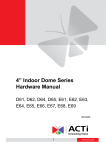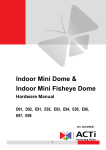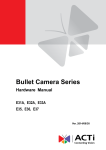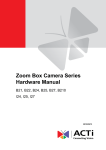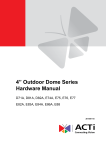Download 3” Indoor Dome Series Hardware Manual
Transcript
3” Indoor Dome Series Hardware Manual D51, D52, D54, D55 E51, E52, E53, E54, E56, E57, E58, E59 Ver. 2014/01/16 Hardware Manual Table of Contents Precautions 4 Safety Instructions ........................................................................... 6 Introduction 7 List of Models.................................................................................... 7 Package Contents............................................................................. 8 Physical Description ........................................................................ 9 D51 / D52 / E51 ............................................................................. 9 D54 / D55 / E52 / E53 / E54 / E56 / E57 / E58 / E59 ..................... 9 Mounting Solutions ........................................................................ 10 Other Mounting Accessories ........................................................ 12 Installing the Camera on a Surface 13 Step 1: Unpack the Camera ........................................................... 13 Step 2: Attach the Mounting Plate ................................................. 14 Step 3: Connect the Cable ............................................................. 15 Step 4: Attach the Fixing Bracket .................................................. 16 Step 5: Install the Camera .............................................................. 17 Step 6: Connect to Network ........................................................... 18 Step 7: Access the Camera Live View ........................................... 18 Step 8: Adjust the Viewing Angle and Focus ............................... 19 Step 9: Close the Dome Cover ....................................................... 19 Other Adjustments and Accessories 21 How to Adjust the Viewing Angle and Focus ............................... 21 D51 / D52 / E51 ........................................................................... 21 D54 / D55 / E52 / E53 / E54 / E56 / E57 / E59 ............................. 22 How to Replace the Dome Cover ................................................... 23 2 Hardware Manual Accessing the Camera 25 Configure the IP Addresses ........................................................... 25 Using DHCP Server to Assign IP Addresses ................................ 25 Using the Default Camera IP Address.......................................... 27 Access the Camera ......................................................................... 29 3 Hardware Manual Precautions Read these instructions You should read all the safety and operating instructions before using this product. Heed all warnings You must adhere to all the warnings on the product and in the instruction manual. Failure to follow the safety instruction given may directly endanger people, cause damage to the system or to other equipment. Servicing Do not attempt to service this video device yourself as opening or removing covers may expose you to dangerous voltage or other hazards. Refer all servicing to qualified service personnel. Trademarks All names used in this manual are probably registered trademarks of respective companies. Liability Every reasonable care has been taken during the writing of this manual. Please inform your local office if you find any inaccuracies or omissions. We cannot be held responsible for any typographical or technical errors and reserve the right to make changes to the product and manuals without prior notice. 4 Hardware Manual Federal Communications Commission Statement This equipment has been tested and found to comply with the limits for a class B digital device, pursuant to Part 15 of the FCC Rules. These limits are designed to provide reasonable protection against harmful interference in a residential installation. This equipment generates, uses, and can radiate radio frequency energy and, if not installed and used in accordance with the instructions, may cause harmful interference to radio communications. However, there is no guarantee that interference will not occur in a particular installation. If this equipment does cause harmful interference to radio or television reception, which can be determined by turning the equipment off and on, the user is encouraged to try to correct the interference by one or more of the following measures: Reorient or relocate the receiving antenna. Increase the separation between the equipment and receiver. Connect the equipment into an outlet on a circuit different from that to which the receiver is connected. Consult the dealer or an experienced radio/TV technician for help. Warning: Changes or modifications to the equipment that are not expressly approved by the responsible party for compliance could void the user’s authority to operate the equipment. European Community Compliance Statement This product has been tested and found to comply with the limits for Class B Information Technology Equipment according to European Standard EN 55022 and EN 55024. In a domestic environment, this product may cause radio interference in which cause the user may be required to take adequate measures. 5 Hardware Manual Safety Instructions Don’t open the housing of the product Cleaning Disconnect this video product from the power supply before cleaning. Attachments Do not use attachments not recommended by the video product manufacturer as they may cause hazards. Water and Moisture Do not use this video product near water, for example, near a bathtub, washbowl, kitchen sink, or laundry tub, in a wet basement, or near a swimming pool and the like. Don’t use accessories not recommended by the manufacturer Only install this device in a dry place protected from weather Servicing Do not attempt to service this video product yourself as opening or removing covers may expose you to dangerous voltage or other hazards. Refer all servicing to qualified service personnel. Damage Requiring service Disconnect this video product from the power supply immediately and refer servicing to qualified service personnel under the following conditions. 1) When the power-supply cord or plug is damaged 2) If liquid has been spilled, or objects have fallen into the video product. 3) If the video product has been directly exposed to rain or water. 4) If the video product does not operate normally by following the operating Instructions in this manual. Adjust only those controls that are covered by the instruction manual, as an improper adjustment of other controls may result in damage, and will often require extensive work by a qualified technician to restore the video product to its normal operation. Safety Check Upon completion of any service or repairs to this video product, ask the service technician to perform safety checks to determine if the video product is in proper operating condition. 6 Hardware Manual Introduction List of Models This hardware manual contains the following models: D51 1MP Indoor Dome with Fixed Lens D52 3MP Indoor Dome with Fixed Lens D54 1MP Indoor Dome with D/N, IR, Fixed lens D55 3MP Indoor Dome with D/N, IR, Fixed lens E51 1MP Indoor Dome with Basic WDR, Fixed lens E52 1MP Indoor Dome with D/N, IR, Basic WDR, Fixed lens E53 3MP Indoor Dome with D/N, IR, Basic WDR, Fixed lens E54 5MP Indoor Dome with D/N, IR, Basic WDR, Fixed lens E56 3MP Indoor Dome with D/N, IR, Superior WDR, Fixed lens E57 1.3MP Indoor Dome with D/N, IR, Basic WDR, SLLS, Fixed lens E58 2MP Indoor Dome with D/N, IR, Basic WDR, SLLS, Fixed lens E59 10MP Indoor Dome with D/N, IR, Basic WDR, Fixed lens From the installation perspective, these models are similar; therefore, one manual is used for all of them. 7 Hardware Manual Package Contents Camera or Mounting Screw Kit Drill Template Drill Template Lens Focus Tuner Fixing Bracket and Screws (Not available in D51, D52, E51, E59) (Not available in D51, D52, E51) Quick Installation Guide Warranty Card 8 Hardware Manual Physical Description D51 / D52 / E51 D54 / D55 / E52 / E53 / E54 / E56 / E57 / E58 / E59 1) Ethernet Port Connects to the network using a standard Ethernet cable (CAT5 / CAT6). 2) Reset Button Restores the camera factory default settings. To do the reset, press and hold the Reset Button for at least 5 seconds or until the Ethernet port LEDs turn off. 9 Hardware Manual Mounting Solutions There are several mounting solutions that you can use to install the camera. Select the most suitable solution for your installation environment. Mount Types Accessories Surface Mount Suitable when mounting the camera directly to walls or ceilings. See Installing the Camera on a Surface on page 13 for mounting instructions. Flush Mount Suitable when mounting the camera discretely above dropped ceilings wherein only the dome cover will be visible underneath the ceiling. PMAX-1006 Gang Box Suitable when mounting the camera in specific regions where the use of gang box is required by law. PMAX-0803 Pendant Mount Suitable when mounting the camera on hard and high ceilings. PMAX-0101 PMAX-0103 (Straight Tube with Bracket) PMAX-0101 PMAX-0102 (Straight Tube) 10 Hardware Manual Straight Wall Suitable when mounting the camera on straight walls. Mount PMAX-0308 (L-Type Wall Mount) PMAX-0101 Vertical Pole Mount Horizontal Pole PMAX-0305 (Heavy Duty Wall Mount) Suitable when mounting the camera on vertical poles. PMAX-0101 PMAX-0305 PMAX-0503 Suitable when mounting the camera on horizontal poles. Mount PMAX-0101 Corner Mount PMAX-0102 PMAX-0503 Suitable when mounting the camera on a corner wall. PMAX-0101 PMAX-0305 11 PMAX-0402 Hardware Manual Other Mounting Accessories Accessories PMAX-0104 (Extension Tube) NOTE: For more information about the mounting solutions and accessories, please check the Mounting Accessory Selector in our website ( The above mounting accessories are not included in the package. Contact your sales agents to purchase. 12 Hardware Manual Installing the Camera on a Surface This section describes the procedures in installing the camera directly on a flat surface, such as the ceiling or the wall. For simplicity, most of the camera images used in the succeeding sections were taken using the camera model with heat sink; same procedures apply to the model without heat sink unless specified. Step 1: Unpack the Camera NOTE: To avoid scratches or leaving fingerprints on the dome cover, it is recommended to retain the plastic covering the dome cover until the camera is completely installed. 1. Slide the mounting plate counter-clockwise to detach it from the camera. 2. Remove the silicon bag. 13 Hardware Manual Step 2: Attach the Mounting Plate NOTE: Before installation, consider the camera viewing angle and logo placement. The arrow on the drill template and mounting plate align with the direction of the camera logo. Rotate the drill template as needed. 1. Using the drill template, mark the holes on the surface. If necessary, drill the three (3) screw holes and insert the plastic plugs. This arrow aligns with the camera logo. Rotate the template, as needed. 2. Determine how the cable will be routed: a. The cable will pass through a hole on the surface: In this case, drill the cable hole based on the drill template. b. The cable will go along the surface: Skip this step. 3. Attach the mounting plate on the surface using the three (3) supplied screws. Note that the direction of the arrow on the mounting plate aligns with the camera logo. NOTE: Make sure the screw is flat on the plate. 14 Hardware Manual Step 3: Connect the Cable 1. If the cable will pass through the hole on the surface, route the network cable through the hole. If the cable will go along the surface, remove the cable exit tab on the camera and route the cable along the surface. or Cable Passing Through a Hole on the Surface Cable Going Along the Surface 2. Connect the network cable to the Ethernet port of the camera. 15 Hardware Manual Step 4: Attach the Fixing Bracket This step is required only for D54, D55, E52, E53, E54, E56, E57, E58, E59 camera models with cables going along the surface. Otherwise, skip this step. 1. Route the cable to pass through the gap on the camera. 2. Attach the fixing bracket using the two (2) supplied screws to secure the cable. 16 Hardware Manual Step 5: Install the Camera 1. If the cable passes through a hole on the surface, push the extra length of cable into the hole. Otherwise, skip this step. 2. With the arrow on the mounting plate aligned to the direction of the camera logo, insert the hooks on the camera to the slots on the mounting plate. Logo is here Arrow is here 3. Slide the camera clockwise until it locks into place. 17 Hardware Manual Step 6: Connect to Network Connect the other end of the network cable to a Power-over-Ethernet (PoE) switch or injector. Then, connect the PoE switch or injector to a network or PC and a power source. See example connection diagram below. Network Ethernet Cable Ethernet Cable (Data) Ethernet Cable (Data + Power) PoE Injector / PoE Switch Power Cable AC Power Source Camera Step 7: Access the Camera Live View See Accessing the Camera on page 25 for more information on how to access the Live View screen of the camera. 18 Hardware Manual Step 8: Adjust the Viewing Angle and Focus 1. Rotate the dome cover counter-clockwise and then pull to remove it. 2. Based on the live view, adjust the viewing angle and orientation of the camera. Adjustments vary depending on model; see How to Adjust the Viewing Angle and Focus on page 21 for detailed information. Step 9: Close the Dome Cover 1. Slightly press on the edges of the dome cover and push it into the groove until it clicks. 2. Remove the plastic covering the dome cover. 19 Hardware Manual Below is an installation example. 20 Hardware Manual Other Adjustments and Accessories How to Adjust the Viewing Angle and Focus This section describes the procedures in adjusting the viewing angle and focus of the camera. D51 / D52 / E51 Camera Parts Overview Adjustment Procedures 1. Loosen the tilt adjustment screws, adjust the tilt, and then tighten back the screws to fix the tilt position. 2. Move the rotation adjustment to rotate the viewing orientation. 3. Attach the bundled lens focus tuner unto the lens and turn left or right to adjust the focus. 2 1 21 Hardware Manual D54 / D55 / E52 / E53 / E54 / E56 / E57 / E59 Camera Parts Overview Adjustment Procedures 1. Loosen the tilt adjustment screws, adjust the tilt, and then tighten back the screws to fix the tilt position. 2. Move the rotation adjustment to rotate the viewing orientation. 2 1 3. Attach the bundled lens focus tuner unto the lens and turn left or right to adjust the focus. NOTE: Focus adjustment is not available for E59 because the camera already comes with fixed focus and fixed viewing angle. 22 Hardware Manual How to Replace the Dome Cover For more discrete surveillance needs, the bundled dome cover can be replaced with a smoke dome cover available for purchase. To replace the dome cover, do the following: 1. Rotate the current dome cover counter-clockwise and then pull to remove it. 2. Align the shroud of the replacement dome cover to the camera lens. 3. Slightly press on the edges of the dome cover and push it into the groove until it clicks. 23 Hardware Manual 4. Remove the plastic covering the dome cover. 24 Hardware Manual Accessing the Camera Configure the IP Addresses In order to be able to communicate with the camera from your PC, both the camera and the PC have to be within the same network segment. In most cases, it means that they both should have very similar IP addresses, where only the last number of the IP address is different from each other. There are 2 different approaches to IP Address management in Local Area Networks – by DHCP Server or Manually. Using DHCP Server to Assign IP Addresses If you have connected the computer and the camera into the network that has a DHCP server running, then you do not need to configure the IP addresses at all – both the camera and the PC would request a unique IP address from DHCP server automatically. In such case, the camera will immediately be ready for the access from the PC. The user, however, might not know the IP address of the camera yet. It is necessary to know the IP address of the camera in other to be able to access it by using a Web browser. The quickest way to discover the cameras in the network is to use the simplest network search, built in the Windows system – just by pressing the “Network” icon, all the cameras of the local area network will be discovered by Windows thanks to the UPnP function support of our cameras. In the example below, we successfully found the camera that we had just connected to the network. 25 Hardware Manual By double-clicking with the left mouse on the camera model, it is possible to automatically launch the default browser of the PC with the IP address of the target camera filled in the address bar of the browser already. If you work with our cameras regularly, then there is even a better way to discover the cameras in the network – by using IP Utility. The IP Utility is a light software tool that can not only discover the cameras, but also list lots of valuable information, such as IP and MAC addresses, serial numbers, firmware versions, etc, and allows quick configuration of multiple devices at the same time. The IP Utility can be downloaded for free from With just one click, you can launch the IP Utility and there will be an instant report as follows: You can quickly see the camera model in the list. Click on the IP address to automatically launch the default browser of the PC with the IP address of the target camera filled in the address bar of the browser already. 26 Hardware Manual Using the Default Camera IP Address If there is no DHCP server in the given network, the user may have to assign the IP addresses to both PC and camera manually to make sure they are in the same network segment. When the camera is plugged into network and it does not detect any DHCP services, it will automatically assign itself a default IP: 192.168.0.100 Whereas the default port number would be 80. In order to access that camera, the IP address of the PC has to be configured to match the network segment of the camera. Manually adjust the IP address of the PC: In the following example, based on Windows 7, we will configure the IP address to 192.168.0.99 and set Subnet Mask to 255.255.255.0 by using the steps below: 1 3 2 4 27 Hardware Manual Manually adjust the IP addresses of multiple cameras: If there are more than 1 camera to be used in the same local area network and there is no DHCP server to assign unique IP addresses to each of them, all of the cameras would then have the initial IP address of 192.168.0.100, which is not a proper situation for network devices – all the IP addresses have to be different from each other. The easiest way to assign cameras the IP addresses is by using IP Utility: With the procedure shown above, all the cameras will have unique IP addresses, starting from 192.168.0.101. In case there are 20 cameras selected, the last one of the cameras would have the IP 192.168.0.120. Later, by pressing the “Refresh” button of the IP Utility, you will be able to see the list of cameras with their new IP addresses. Please note that it is also possible to change the IP addresses manually by using the Web browser. In such case, please plug in only one camera at a time, and change its IP address by using the Web browser before plugging in the next one. This way, the Web browser will not be confused about two devices having the same IP address at the same time. 28 Hardware Manual Access the Camera Now that the camera and the PC are both having their unique IP addresses and are under the same network segment, it is possible to use the Web browser of the PC to access the camera. You can use any of the browsers to access the camera, however, the full functionality is provided only for Microsoft Internet Explorer. The browser functionality comparison: Functionality Internet Explorer Other browsers Live Video Yes Yes* Live Video Area Resizable Yes No PTZ Control Yes Yes Capture the snapshot Yes Yes Yes No Yes Yes Video overlay based configuration (Motion Detection regions, Privacy Mask regions) All the other configurations * When using non-Internet Explorer browsers, free third-party software plug-ins must be installed to the PC first to be able to get the live video feed from the camera. Check the firmware version of the camera to determine which plug-in is necessary: Firwmware Version A1D-500-V6.04.xx-AC or older A1D-500-V6.05.xx-AC or newer Required Plug-In Basic VLC Media Player QuickTime ( The camera firmware version can be found on the FW Version column of the IP utility or access the Setup page of the Web Configurator (see page 31). Disclaimer Notice: The camera manufacturer does not guarantee the compatibility of its cameras with VLC player or QuickTime – since these are third party softwares. The third parties have the right to modify their utility any time which might affect the compatibility. In such cases, please use Internet Explorer browser instead. When using Internet Explorer browser, the ActiveX control for video stream management will be downloaded from the camera directly – the user just has to accept the use of such control when prompted so. No other third party utilities are required to be installed in such case. 29 Hardware Manual The following examples in this manual are based on Internet Explorer browser in order to cover all functions of the camera. Assuming that the camera’s IP address is 192.168.0.100, you can access it by opening the Web browser and typing the following address into Web browser’s address bar: Upon successful connection to the camera, the user interface called Web Configurator would appear together with the login page. The HTTP port number was not added behind the IP address since the default HTTP port of the camera is 80, which can be omitted from the address for convenience. Before logging in, you need to know the factory default Account and Password of the camera. Account: Admin Password: 123456 30 Hardware Manual To check the firmware version through the Web Configurator, access the Setup page and click System > System Info. 1 2 3 For further operations, please refer to the Firmware User Manual. 31
































